Understanding the benefits of urban green spaces on human health could help us take public health measures to transition to greener cities. There are studies that already show that these areas reduce the risk of suffering strokes or that their lack can lead to a higher risk of ADHD or poorer child development. This article presents the latest research by the Barcelona Institute for Global Health (ISGlobal) on urban green spaces.
Trees that save lives
The Friends of Trees organization has planted, over 30 years, a total of 49,246 trees in the streets of Portland (USA). Using the dates and locations of the plantings of the trees, and data from the Oregon Health Area, the research team has analyzed in detail a census area where 4,000 people live. They have related the number and location of trees planted, with mortality from respiratory, cardiovascular and non-accidental causes in this population over the last 5, 10 or 15 years.
“Our results provide a strong scientific basis for guiding tangible interventions such as tree planting aimed at increasing the longevity of urban residents”
Payam Dadvand, ISGlobal
From the data, it is clear that each tree reduces non-accidental mortality by 20% and cardiovascular mortality by 6%. And the longer a tree has been planted, the greater the effect on mortality reduction. The annual costs associated with planting and maintaining these trees have also been taken into account, and the economic benefits far outweigh these costs.
Greener cities, better mental health
Another ISGlobal team surveyed 3,145 Barcelona citizens between 15 and 97 years old and concluded that urban green spaces lead to better mental health, less use of medication and fewer visits to the psychologist.
The study was based on the 3-30-300 rule of green spaces, which implies:
- seeing at least 3 trees from home
- having 30% tree cover in the neighborhood and
- living at most 300 meters from a green space
The results show that despite the improvement in mental health, only 4.7% of respondents complied with this rule. “There is an urgent need to provide more green spaces for citizens”, explains Mark Nieuwenhuijsen first author of the study. “Planting more trees will not only improve health, but will also reduce heat island effects and help capture CO2”, he concludes. As his colleague Cathryn Tonne recently mentioned in an interview about The Lancet Countdown Europe report, climate change and health clearly go hand in hand.
Nieuwenhuijsen M, Dadvand P, Márquez S, Bartoll X, et al. The evaluation of the 3-30-300 green space rule and mental health. Environmental Research, Volume 215, Part 2, 2022, 114387. doi.org:10.1016/j.envres.2022.114387
Donovan, GH, Prestemon JP, Gatziolis D, Michael YL, Kaminski AR, Dadvand P. The association between tree planting and mortality: A natural experiment and cost-benefit analysis. Environment International. 2022. doi.org:10.1016/j.envint.2022.107609







